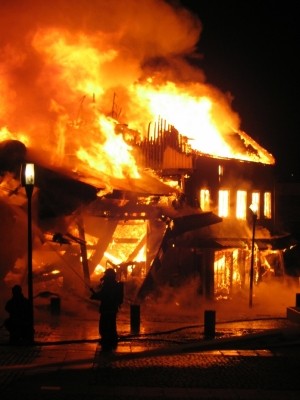Replace old heat tapes with safer, certified new ones... Before they burn the place down!
 By Jay Hensley By Jay Hensley
Old, forgotten, improperly installed or misused heat tapes can and do cause fires, but there are precautions you can take to help electric heat tapes perform their job safely.
Christmas 1995 at the Philadelphia Zoo was a sad time. A tragic weekend fire had killed all the animals in the World of Primates, a section of the Zoo that was a favorite of both staff and visitors.
The fire killed six prized West African low-land gorillas, three Bornean orangutans, four white-haired gibbons and 10 lemurs. All of the victims were on the endangered species list.
The fire started near electric heat tapes that ringed a water pipe above a wooden ceiling. Their purpose was to keep the plumbing from freezing. However, the tapes had been improperly installed, causing the ceiling to become dry and more flammable from long-term exposure to heat generated by the tapes. (This process of lowering the ignition temperature of the material is called “pyrolysis.”)
The December 28, 1995 New York Times reported that Zoo guards smelled smoke almost three hours before the fire broke out, but they thought it came from fires that were often burning in a nearby railroad yard. Smoke detectors at the Zoo failed to go off as the ceiling smoldered.
Fires caused by old and/or improperly installed heat tapes are not all that unusual.
In April 1988, the house and business of the chimney sweep I know in New York burned to the ground. Norm was someone who prided himself on safeguarding customers from the possibility of a house fire, but he narrowly escaped death from the fire in his own home. It was traced to old electric heat tapes.
The tapes were wrapped around water pipe he had disconnected and drained when he bought the house the before and redid the plumbing. He didn’t even know the tapes were there, under the floor, still plugged in!
In another incident some years ago, a rustic rod-and-gun club lodge near my home in the Berkshire Hills of Massachusetts burned down one winter’s day. The cause? Heat tapes installed to keep plumbing operational through the cold weather, when the place was often empty.
Heat tapes are usually installed in attics or underneath porches and homes, especially mobile homes. Chimney sweeps tell me that some folks even wrap tapes around their gutters an effort to keep them from icing up (not recommended!).
According to the Consumer Product Safety Commission (CPSC), there are approximately 2000 fires, 10 deaths and 100 injuries each year involving head tapes.
We quote here from a Consumer Product Safety Alert:
New Electric Heat Tapes Help Prevent Fires
To help prevent fires, the U.S. Consumer Product Safety Commission (CPSC) urges homeowners (including residents of mobile homes) to replace uncertified heat tapes more than three years old. Uncertified heat tapes should be replaced with new heat tapes certified to meet recognized voluntary standards.
At present the following organizations certifying heat tapes to meet recognized voluntary standards: Underwriters Laboratories (UL), the Canadian Standards Association (CSA), and Factory Mutual Research Corporation (FMRC).
CPSC offers these safety tips for purchasing, installing, and maintaining electric heat tapes:
Replace uncertified heat tapes more than 3 years old with new heat tapes certified to meet recognized voluntary standards. All new heat tapes will have a 3-prong plug.
- Always plug the 3-prong plug into a 3-prong outlet to make sure the heat tape is grounded.
- Use a ground-fault circuit-interrupter (GFCI) wherever heat tapes are plugged in.
- Do not wrap heat tape over itself unless specifically permitted in the manufacturer’s instructions.
- Apply heat tapes directly on the pip to be protected, never on top of the insulation covering the pipe.
- Do not cover the heat tape with insulation unless advised by the manufacturer. Use nonflammable insulation such as fiberglass. Do not use foam or vinyl insulation that could catch fire from a failing heat tape.
- Keep the end-cap sealed and off the ground to prevent water from getting in. Moisture can lead to a fire.
- Do not use heat tapes designed for water pipes on gutters, driveways, or fuel lines. If heat tape has a thermostat, check instructions to see if the thermostat should be placed against the pipe and covered with insulation or if it should be left hanging and uncovered. Inspect heat tapes each year and replace them if you notice signs of deterioration. Look for discolored surfaces (especially at the plug), charring, cuts or breaks in the insulation, or bare wires. Check installation instructions when you change types or brands of heat tape because different heat tapes have different installation requirements.
Reprinted, with permission, from the January-February 2008 issue of The Chimney Sweep News, an independent trade magazine for chimney service professionals. Jim Gillam, editor/publisher. 541-882-5196. www.ChimneySweepNews.com
|